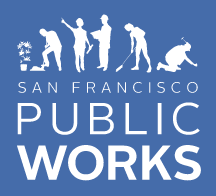Tree Pruning

Pruning can either help or hurt trees. When appropriate practices are used, pruning can provide significant benefits. When inappropriate practices are used, significant harm can follow. For the long-term health and structural stability of trees in San Francisco, it is critical that pruning practices conform to professional standards. The City and County of San Francisco adopted pruning standards that must be adhered to. Remember, damaging a street tree is illegal and Public Works can issue fines for illegal pruning. Here are some guidelines and some tips (PDF) for pruning.
Do not TOP trees. Topping trees is severely damaging to the tree structure. It is illegal in San Francisco and can result in a fine.
Tree topping (also called hat-racking, heading, or rounding over) is the practice of cutting a terminal branch to a stump or to a lateral branch that is not large enough to assume the terminal role. Topping is not an acceptable way to reduce a tree’s canopy. Tree topping results in rapid growth of multiple thin branches below the cut. These new branches are weakly attached and hazardous. Although this flush of new growth may look like the tree is healthy and recovering, they are actually a stress response. Topping can also cause trunk rot, which weakens the structure of the tree and creates more hazards. In fact, a topped tree will require more frequent maintenance than a properly pruned tree. It is not advisable to hire anyone who is willing to top a healthy tree.
Do I need a permit to prune a street tree?
If you have a privately maintained street tree the answer is no, you do not need a permit to prune a tree. However, all street trees are under the jurisdiction of Public Works and San Francisco's tree pruning standards must be followed. Failure to properly prune street trees will damage the long-term health of the tree and may result in a fine. Property owners with the maintenance responsibility for the street trees adjacent to their property are required to follow the tree pruning standards established in San Francisco. Hire a qualified arborist, preferably an arborist who is Certified with the International Society of Arboriculture. We also suggest that you contact the Bureau of Street Use and Mapping to determine if you need a Temporary Occupancy Permit.
Public Works prunes city-maintained trees on a regular schedule depending on the species and age of the trees. If there is a city-maintained tree adjacent to your property and you feel it may need additional pruning, please make your request through 311 (Call 3-1-1 (within SF only) or (415) 701-2311; TTY direct (415) 701-2323 or submit a request online). A staff member from the Bureau of Urban Forestry will inspect the tree and determine the best course of action to preserve public safety and the health of the tree.
How can I hire a certified arborist?
The International Society of Arboriculture (ISA) certifies Arborists and Tree Care Workers. Ask your arborist if they have a certification number. You can also find an arborist through the ISA.
Can I prune my own tree?
Pruning trees is a specialized trade based on the science of tree physiology. Public Works recommends hiring a certified arborist for any tree work. Young tree care, if done carefully, can be performed by the property owner. Learn more with this guide to pruning young trees (PDF).
How can I report illegal pruning or removal?
Call 3-1-1 to report illegal pruning or removal of street trees. The Bureau of Urban Forestry will send an inspector to assess the tree and issue a fine if warranted.
Is pollarding the same as topping?
Sometimes people use the terms interchangeably, but they are actually very different practices. Pollarding a tree is a rigorous pruning practice that is only possible on a very few species of tree (primarily London plane/sycamore species), and it must be begun when a tree is young by a professional arborist. This intensive practice involves cutting a tree’s new growth each year. While pollarding is not recommended, it is not illegal if performed correctly. Topping a tree is extremely damaging to the tree, and should never be done.
Should I prune the canopy if I have to prune the roots?
Seek advice from a certified arborist, but in most cases it is not recommended. Pruning the roots of a tree will stress the tree and should only be done if necessary. We may be able to minimize the number of roots that must be pruned by allowing property owners to expand their tree basin. Call 3-1-1 to request a basin expansion. (It is not possible in all cases, and must follow ADA guidelines, so we can determine what is allowed.)
Contact:
San Francisco Public Works
2323 Cesar Chavez Street
San Francisco, CA 94124
628-652-8733


